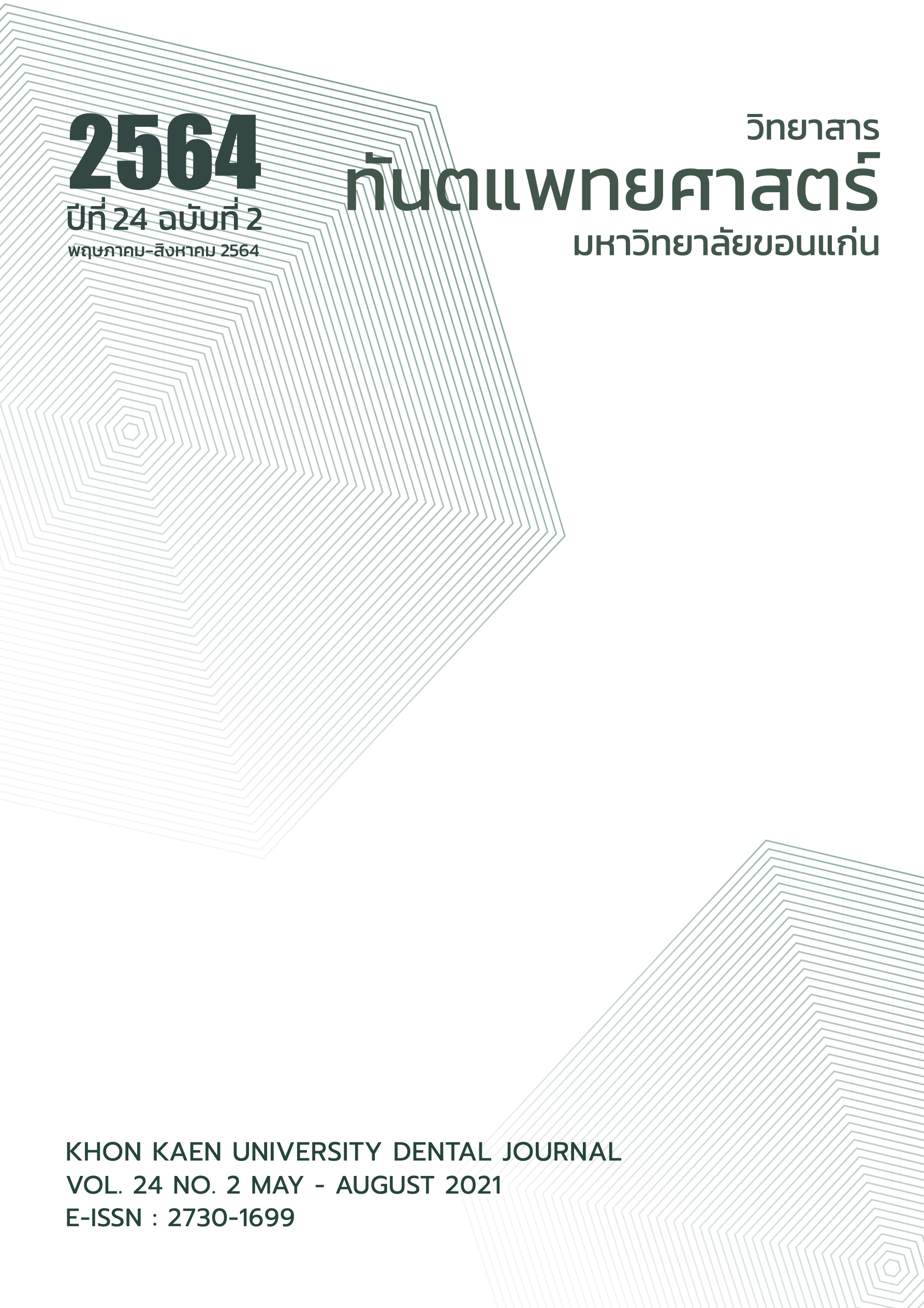Comparative Assessment of Maxillary Central Incisor Position in Thai Females with Facial Harmony VS. Pre-Orthodontic Treatment
Main Article Content
Abstract
The antero-posterior (AP) position of maxillary central incisors (MCI) to the forehead profiles was described by L.F. Andrews as a useful method to assess attractiveness relative to the MCI position. The purpose of this study was to assess the AP position of the MCI in relation to forehead profile among Thai females and compare this MCI position between facial harmony (FH) and pre-orthodontic (pre-OD) groups. Out of 123 lateral smile profile photographs with MCI clearly visible of adult female volunteers (ages 18-30 years), 33 photographs with harmonious facial profiles were selected as the FH group. Thirty-three matched age and gender pre-orthodontic patient photographs were randomly selected as the pre-OD group. All photographs were consistently recolored, resized and rotated to estimated natural head position (ENHP). Landmarks of MCI position and forehead profile were located and measured. The mean distance between Forehead Anterior Limited Line and Dentition Anterior Limited Line (FALL-DALL distance) representing AP position of MCI was significantly different between the FH and pre-OD groups (-0.18±4.42 mm VS 3.49±3.35 mm respectively, p<.001). No significant differences were observed in forehead inclination between the two groups (12.80±5.69 degrees VS 15.05±3.48 degrees respectively, p=.058). There was a significant positive correlation between FALL-DALL distance and forehead inclination in the FH group (r=0.497, p=.003). The linear regression equation for prediction of MCI position (FALL-DALL distance) from forehead inclination was: FALL-DALL distance (mm) = (Forehead inclination (degree)x0.39) -5.76. To achieve facial harmony in orthodontic treatment planning, forehead inclination could be one of the important landmarks to determine the appropriate AP position of MCI.
Article Details
บทความ ข้อมูล เนื้อหา รูปภาพ ฯลฯ ที่ได้รับการลงตีพิมพ์ในวิทยาสารทันตแพทยศาสตร์ มหาวิทยาลัยขอนแก่นถือเป็นลิขสิทธิ์เฉพาะของคณะทันตแพทยศาสตร์ มหาวิทยาลัยขอนแก่น หากบุคคลหรือหน่วยงานใดต้องการนำทั้งหมดหรือส่วนหนึ่งส่วนใดไปเผยแพร่ต่อหรือเพื่อกระทำการใด ๆ จะต้องได้รับอนุญาตเป็นลายลักษณ์อักษร จากคณะทันตแพทยศาสตร์ มหาวิทยาลัยขอนแก่นก่อนเท่านั้น
References
Lopez Y, Le Rouzic J, Bertaud V, Pérard M, Le Clerc J, Vulcain JM. Influence of teeth on the smile and physical attractiveness. A new internet based assessing method OJST 2013;3(1):52-7.
Proffit WR, Fields HW, Sarver DM. Contemporary Orthodontic - 5th ed. Mosby. 2013:2-4.
Kilpelainen PV, Phillips C, Tulloch JF. Anterior tooth position and motivation for early treatment. Angle Orthod 1993;63(3):171-4.
Baumrind S, Frantz RC. The reliability of head film measurements. 2. Conventional angular and linear measures. Am J Orthod 1971;60(5):505-17.
Baumrind S, Frantz RC. The reliability of head film measurements. 1. Landmark identification. Am J Orthod 1971;60(5):111-27.
Andrews LF. Six elements Orthodontics. Andrews J Orthod Orofac Harmony 2000;1:1-8.
Hoefert CS, Bacher M, Herberts T, Krimmel M, Reinert S, Hoefert S, et al. Implementing a superimposition and measurement model for 3D sagittal analysis of therapy-induced changes in facial soft tissue: a pilot study. J Orofac Orthop 2010;71(3):221-34.
McCance AM, Moss JP, Fright WR, Linney AD, James DR. Three-dimensional analysis techniques-Part 2: Laser scanning: a quantitative three-dimensional soft-tissue analysis using a color-coding system. Cleft Palate Craniofac J 1997;34(1):46-51.
Andrews WA. AP relationship of the maxillary central incisors to the forehead in adult white females. Angle Orthod 2008;78(4):662-9.
Adams M, Andrews W, Tremont T, Martin C, Razmus T, Gunel E, et al. Anteroposterior relationship of the maxillary central incisors to the forehead in adult white males. Orthodontics: The Art & Practice of Dentofacial Enhancement 2013;14(1):e2-9.
Schlosser JB, Preston CB, Lampasso J. The effects of computer-aided anteroposterior maxillary incisor movement on ratings of facial attractiveness. Am J Orthod Dentofacial Orthop 2005;127(1):17-24.
Gidaly MP, Tremont T, Lin CP, Kau CH, Souccar NM. Optimal antero-posterior position of the maxillary central incisors and its relationship to the forehead in adult African American females. Angle Orthod 2019; 89(1): 123-8.
Cao L, Zhang K, Bai D, Jing Y, Tian Y, Guo Y. Effect of maxillary incisor labiolingual inclination and anteroposterior position on smiling profile esthetics. Angle Orthod 2011;81(1):121-29.
Charoenpong H KA, Engkatanachai K, Patimaarak C, Chanchaichujit G, Chotesmithkul C, Sunthonkitjarak W, Boonlee P, Akkaraitthiphong P. Effect of incisor position and inclination on smiling profile attractiveness. Bulletin of Health, Science and Technology 2015; 13(2):67-74.
Satravaha S, Schlegel KD. The significance of the integumentary profile. Am J Orthod Dentofacial Orthop 1987;92(5):422-6.
Jiang J, Xu T, Lin J. The relationship between estimated and registered natural head position. Angle Orthod 2007;77(6):1019-24.
Andrews WA, Andrews, LF. Syllabus of the Andrews Orthodontics Philosophy. 8thed. San Siego, Calif: Lawrence F Andrews. 1999.
Donatelli RE, Lee SJ. How to report reliability in orthodontic research: Part 1. Am J Orthod Dentofacial Orthop 2013;144(1):156-61.
Kim HY. Statistical notes for clinical researchers: Evaluation of measurement error 2: Dahlberg's error, Bland-Altman method, and Kappa coefficient. Restor Dent Endod 2013;38(3):182-5.
Kim JM, “AP Relationship of the Maxillary Central Incisors to the Forehead in Adult Korean Females” (2012). Graduate Theses, Dissertations, and Problem Reports. 638.
Lamberton CM, Reichart PA, Triratananimit P. Bimaxillary protrusion as a pathologic problem in the Thai. Am J Orthod 1980;77(3):320-9.
Suntornlohanakul S, Jongphairotkhosit J, Rumphai A. Lip changes after premolar extraction in Class I bimaxillary protrusion: A retrospective study in Thai female adults. Orthod Waves 2018;77(1):10-7.
Soh J, Chew MT, Wong HB. A comparative assessment of the perception of Chinese facial profile esthetics. Am J Orthod Dentofacial Orthop 2005;127(6):692-9.
Mantzikos T. Esthetic soft tissue profile preferences among the Japanese population. Am J Orthod Dentofacial Orthop. 1998;114(1):1-7.


